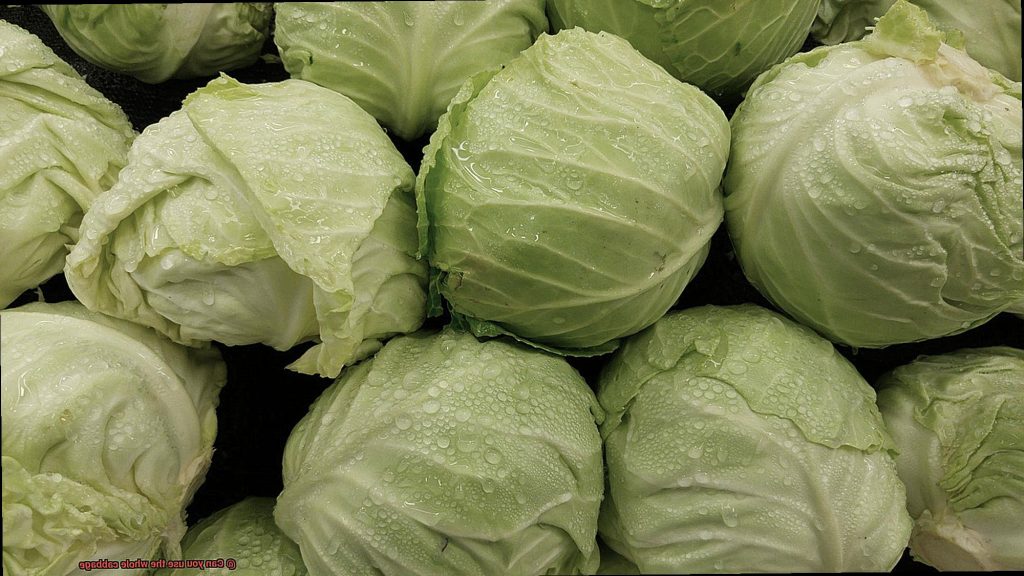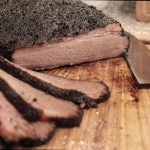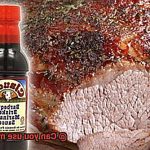Do you hate throwing away food and money? Well, here’s a secret – you can use the whole cabbage. That’s right, every part of the cabbage head is edible and packed with nutrients that you don’t want to miss out on.
When most people think of cabbage, they usually only use the outer leaves and toss the rest. But did you know that the inner leaves and core are just as delicious? The core may not look too appetizing, but it’s loaded with fiber and vitamins A, C, and K. Don’t let it go to waste – chop it up and add it to your soups or stews for an extra boost of nutrition.
And wait, there’s more. Even the outer leaves and stem can be transformed into a tasty snack. Just season them up and roast them for some crispy cabbage chips that are perfect for snacking on while binging your favorite show.
By using every part of the cabbage, you’ll not only reduce food waste but also get more bang for your buck. Plus, you’ll add some variety and nutrients to your meals. So next time you whip up a cabbage dish, think twice before tossing any part of it. You’ll be amazed at how much goodness you can get out of one humble vegetable.
Contents
What is Cabbage?
Cabbage, a member of the Brassicaceae family, is a leafy vegetable that has been cultivated for thousands of years. This biennial plant is known for its versatility in cooking and comes in a variety of colors like green, red, and purple.
But cabbage isn’t just tasty – it’s also incredibly nutritious. Packed with vitamins C and K, antioxidants, and dietary fiber, cabbage is an excellent addition to any healthy diet. And with low calories, it’s the perfect choice for those looking to maintain a healthy weight.
When it comes to cooking with cabbage, there are many creative ways to use this versatile veggie. Did you know that you can use the whole cabbage? From the outer leaves to the tough core in the center, there are plenty of ways to incorporate every part of this nutritious vegetable.
Let’s start with the outer leaves. Although they may be thicker and tougher than the inner leaves, they still contain essential nutrients like vitamin C and dietary fiber. One way to use them is to blanch them in boiling water for a few minutes until they soften. Then wrap them around fillings like rice or ground meat to make delicious stuffed cabbage rolls.
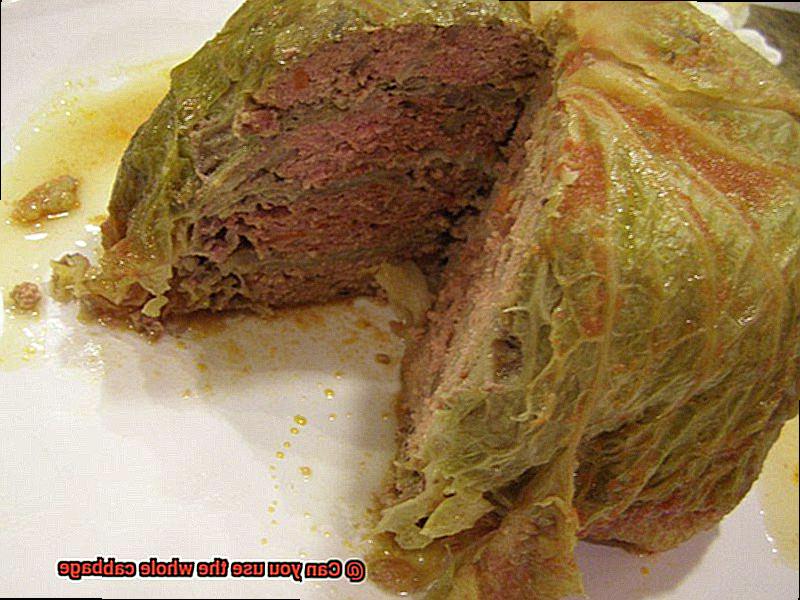
Moving on to the core of the cabbage, many people consider it too tough and fibrous to eat. However, shredding or cutting it into small pieces before adding it to soups or stews can add a depth of flavor and additional nutrition. And don’t forget about the inner leaves. These tender leaves can be used in salads or sautéed as a side dish.
Whether eaten raw or cooked, cabbage is incredibly versatile in the kitchen. It can be used in soups, stews, stir-fries, sauerkraut, and even raw in salads. Its unique flavor profile adds a little extra something to any dish.
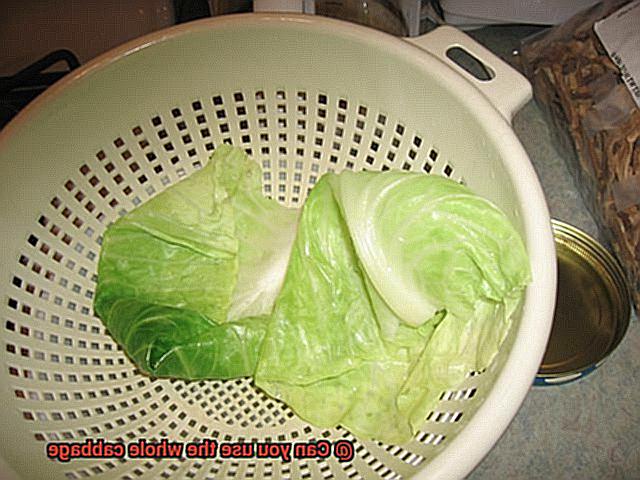
Nutritional Benefits of Cabbage
Look no further than cabbage. This versatile leafy green is not only low in calories but also high in fiber, making it an excellent addition to any meal. But what exactly are the nutritional benefits of cabbage, you ask? Let’s dive in and explore.
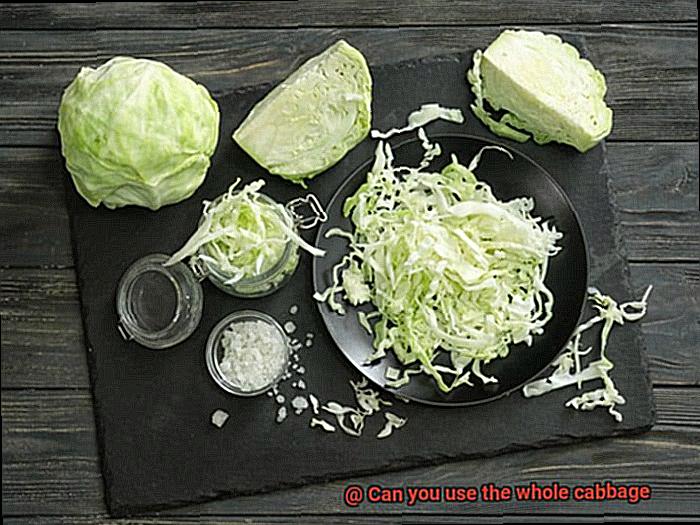
Firstly, cabbage is an excellent source of essential vitamins. Vitamin C is a powerful antioxidant that boosts your immune system and protects against disease. Vitamin K is essential for blood clotting and bone health, while vitamin B6 plays a crucial role in brain function and the production of red blood cells.
But wait, there’s more. Cabbage is also rich in antioxidants, which protect your body against free radical damage. These compounds have been linked to a reduced risk of chronic diseases such as cancer, heart disease, and diabetes. And if you’re expecting, you’ll be happy to know that cabbage is also an excellent source of folate, which helps prevent birth defects.
One of the unique nutritional benefits of cabbage is its high content of glucosinolates. These compounds have potent anti-cancer properties and can help detoxify your body. Studies have shown that consuming cruciferous vegetables like cabbage can reduce the risk of certain types of cancer, including breast, colon, and lung cancer.
Moreover, incorporating cabbage into your diet can provide a range of health benefits. Here are some additional reasons why you should consider adding cabbage to your meal plan:
- Cabbage is low in calories and high in fiber, making it an excellent addition to weight loss diets.
- Cabbage contains anthocyanins, which have been linked to improved heart health.
- The sulfur compounds found in cabbage may help improve digestion and reduce inflammation.
- Cabbage contains calcium and potassium, which are essential for bone health.
So whether you’re using cabbage in soups, stews, salads, or sauerkraut, you can feel good about the nutritional benefits it provides. Don’t let anything go to waste – every part of the cabbage can be used creatively in cooking to add flavor and nutrition to your dishes.
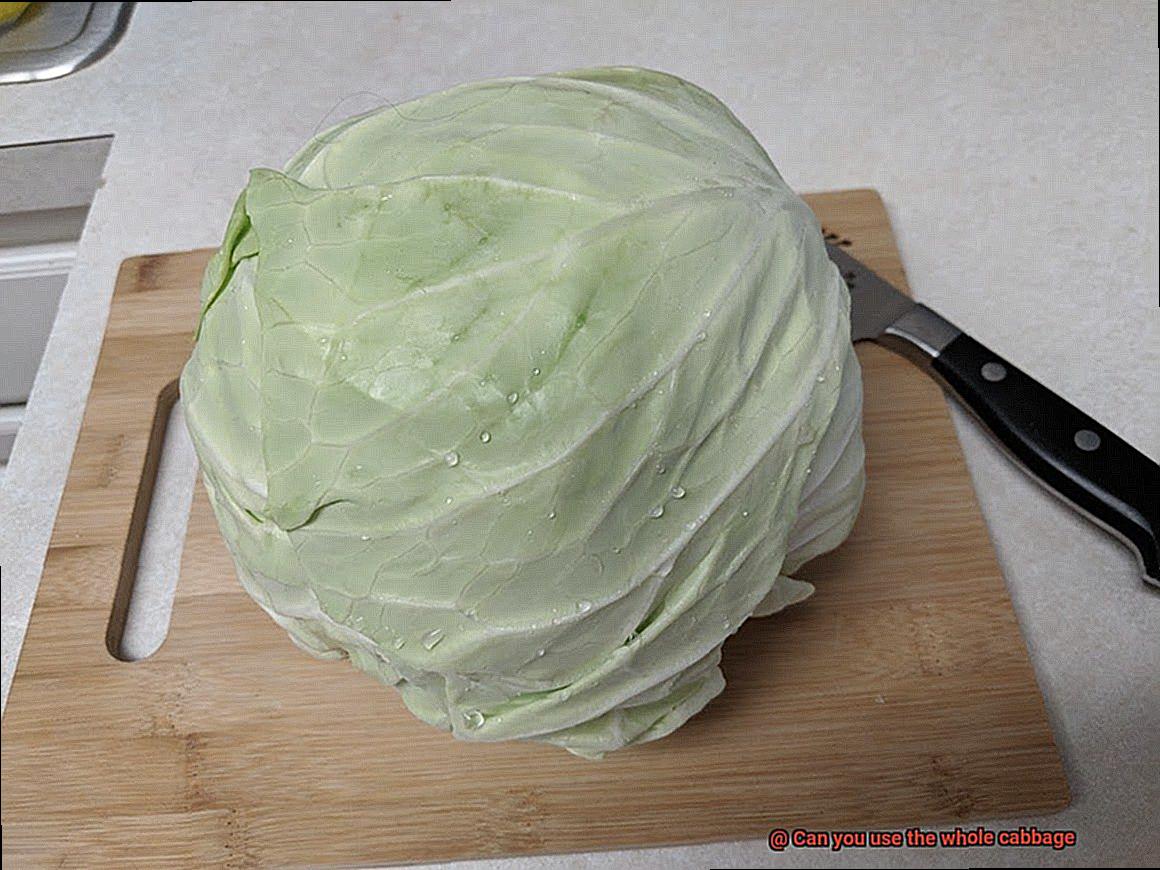
Using the Outer Leaves of Cabbage
Well, it’s time to change that and explore the many ways you can use these versatile and nutritious leaves.
Firstly, these outer leaves make for fantastic natural wraps for grilling. Their sturdy and flexible nature makes them perfect for wrapping around meat or vegetables. Add a subtle flavor to your grilled food while keeping it moist by using these cabbage leaves as a wrap.
But wait, there’s more. You can also chop up these outer leaves and add them to salads or coleslaw. Although they may be tougher and more fibrous than the inner leaves, slicing them thinly or shredding them finely can add a delightful crunch and texture to your dishes. Alternatively, use the outer leaves in soups or stews where they will break down and add extra nutrition to your meal.
One thing to keep in mind is that the outer leaves may have a slightly different flavor than the inner leaves due to their exposure to sunlight. To combat this, you can blanch the cabbage leaves before using them in your recipe. Simply place them in boiling water for 1-2 minutes, then transfer them to a bowl of ice water to stop the cooking process.
Using the Core of Cabbage
Well, it’s time to put an end to that wasteful habit. As an expert in utilizing the core of cabbage, I can attest that this often overlooked part of the vegetable is not only edible but also packed with nutrients. Let’s dive into some exciting ways to use it in your cooking.
First on the list is coleslaw. Instead of tossing away the core, shred it along with the rest of the cabbage and mix it with your favorite dressing and other ingredients. This will give your coleslaw an extra crunch and loads of nutrition.
If you’re a fan of soups and stews, then adding the core of cabbage is an excellent way to enhance flavor and texture while providing additional nutrients. Cut it into smaller pieces and cook it for a longer time than the rest of the vegetables in the soup for maximum flavor.
For those who love stir-fries, thinly sliced cabbage core is a great addition to your dish. Stir-fry it with other vegetables and protein for a quick and nutritious meal.
Lastly, roasted cabbage core is a delicious side dish that is easy to make. Slice the core into thin pieces and roast them in the oven with some olive oil, salt, and pepper until they are crispy on the outside and tender on the inside.
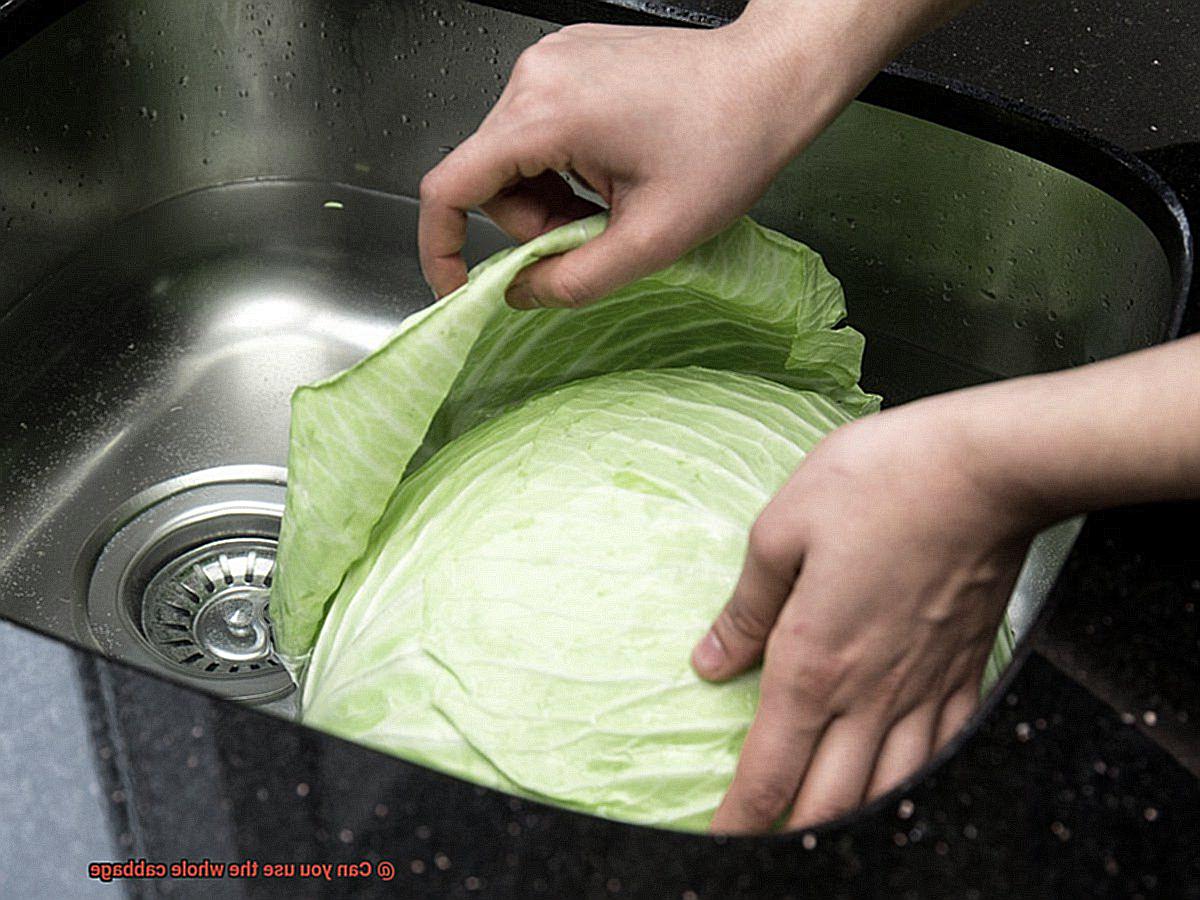
Using the Inner Leaves of Cabbage
Don’t discard them just yet. As an expert in utilizing this often overlooked part, I’m here to show you how to turn it into a crunchy and nutritious addition to your favorite dishes.
Start by choosing a fresh head of cabbage with tight, compact leaves. Once you have your cabbage, remove the outer leaves and focus on the inner ones. These leaves are packed with valuable nutrients and can be used in a variety of ways to create delicious and healthy meals.
One popular use for cabbage leaves is as a wrap. To prepare them, blanch these leaves briefly in boiling water to soften them up. Then fill them with your favorite ingredients like rice, vegetables, or meat. Roll them up and secure with toothpicks or string before grilling for a delightful flavor that will excite your taste buds.
Another option is to use the cabbage leaves as a bed for grilling other foods. These leaves will help prevent sticking and add flavor to your dish. It’s a great way to get creative with your grilling game and impress your guests.
If you’re looking for a quick and easy way to incorporate cabbage into your meals, simply chop up the inner leaves and add them to salads or stir-fries for extra crunch and nutrition. Did you know that cabbage leaves are high in vitamin C and fiber? That’s right, they’re not just delicious but also super healthy.
Tips for Cooking with Whole Cabbage
Cooking with whole cabbage can be a daunting task, but with the right tips and tricks, it can be a versatile and delicious ingredient to work with. Here are five sub-sections of tips to keep in mind when cooking with whole cabbage:
Choosing the Right Cabbage
The first step to cooking with whole cabbage is selecting the right one. Choose a cabbage that is firm, heavy, and has tight leaves. Avoid any cabbages with soft spots or blemishes. Additionally, consider the size of the cabbage you need for your recipe and cooking method.
Prepping the Cabbage
Before cooking, remove any outer leaves that may be wilted or damaged. Rinse the cabbage under cold water and pat dry. Cut off the stem at the bottom of the cabbage, leaving the core intact.
Experimenting with Cooking Methods
Whole cabbage can be cooked in various ways, including grilling, roasting, boiling, and steaming. Each method will provide a different texture and flavor to the cabbage. For example, grilling or roasting can add a smoky flavor, while boiling or steaming can result in a softer texture.
Adding Flavorful Ingredients
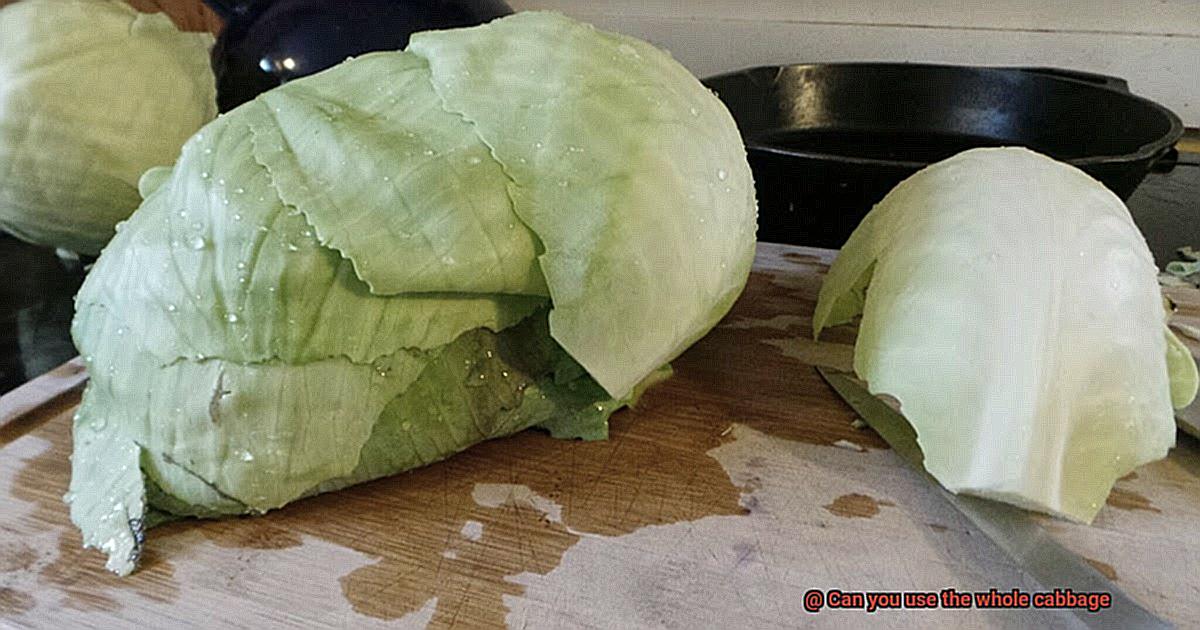
Whole cabbage can be bland on its own, so it’s crucial to add flavorful ingredients to enhance its taste. Consider adding spices, herbs, sauces, or even stuffing the cabbage with ground meat or rice. Get creative and experiment with different flavor combinations to find what works best for you.
Cooking until Tender
Regardless of the cooking method you choose, make sure to cook the cabbage until it is fork-tender. Overcooked cabbage will become mushy and lose its flavor and texture. Keep an eye on the cooking time and adjust as necessary.
Different Ways to Eat Whole Cabbage
Don’t toss them out just yet. With a little creativity, you can use the entire cabbage to create delicious and healthy dishes. Here are five ways to eat a whole cabbage and reduce food waste.
Stuffed Cabbage Rolls
Say goodbye to boring stuffed peppers and try stuffed cabbage rolls instead. First, remove the core of the cabbage and blanch the whole head in boiling water until the leaves are pliable. Then, fill each leaf with your desired stuffing, such as ground beef or rice and vegetables. Roll them up tightly and bake in the oven until tender. The result is a savory and satisfying dish that is perfect for a hearty dinner.
Grilled Cabbage
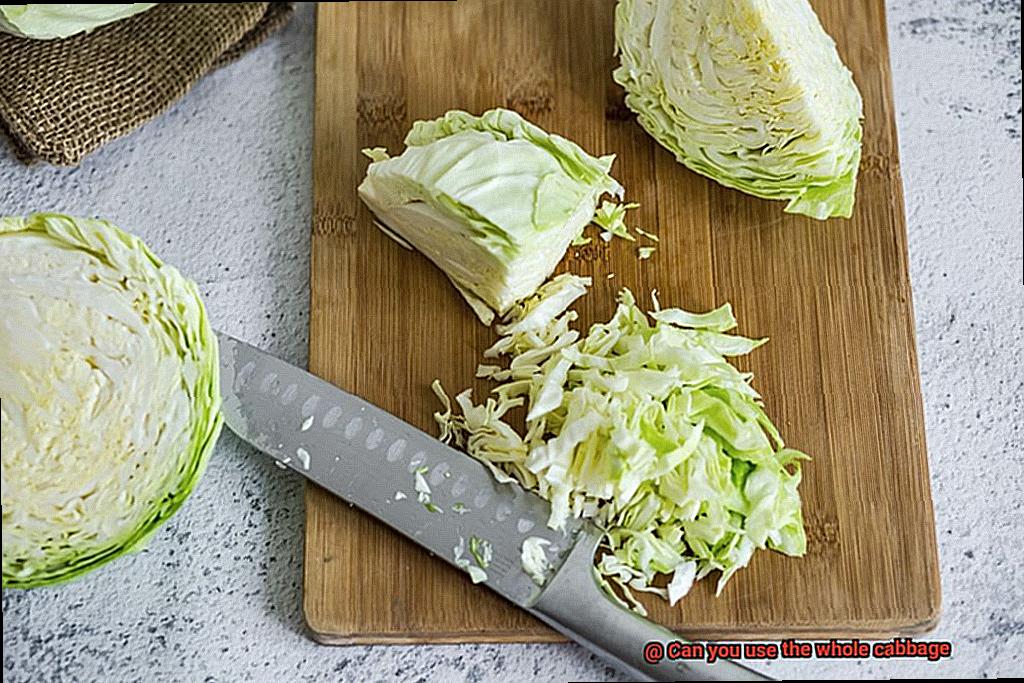
Want to add more flavor to your veggies? Cut the cabbage into thick slices and brush with olive oil. Season with salt and pepper and grill until slightly charred and tender. This makes for a smoky and delicious side dish that is easy to prepare.
Coleslaw
No list of cabbage recipes would be complete without coleslaw. Shred the cabbage finely and mix with shredded carrots, sliced onions, and your favorite dressing for a crunchy and refreshing salad. It’s perfect for picnics, BBQs, or as a side dish for any meal.
Fermented Cabbage (Sauerkraut)
If you’re feeling adventurous, try making your own sauerkraut at home. Shred the cabbage finely and mix with salt, then pack it tightly into a jar or crock and let it ferment for several weeks. The result is tangy, probiotic-rich sauerkraut that can be used as a condiment or side dish.
Kimchi
Take your fermented cabbage game to the next level by making kimchi with a whole cabbage. Cut out the core and stuff the head with a mixture of garlic, ginger, chili flakes, fish sauce, and other seasonings. Let it ferment for a few days at room temperature before storing in the refrigerator. The result is a spicy and flavorful dish that can be used in stir-fries, sandwiches, or eaten as a snack.
Benefits of Eating Whole Cabbage
Look no further than the humble cabbage. This low-calorie vegetable is often overlooked, but it’s packed with essential nutrients that can benefit your health in numerous ways. And the best part? You don’t have to waste any part of it. By using the whole cabbage, you can enjoy all of its benefits. As an expert on the benefits of eating whole cabbage, let me take you through some of the top reasons why you should start incorporating this versatile veggie into your diet.
First and foremost, whole cabbage is a nutrient powerhouse. It contains vitamins and minerals such as vitamin C, vitamin K, folate, calcium, and potassium. These nutrients are essential for maintaining good health and can help prevent chronic diseases like cancer and heart disease. Plus, eating a variety of nutrient-dense foods like cabbage can help boost your energy levels and improve your overall wellbeing.
But that’s not all. Whole cabbage is also high in fiber, which can help improve digestion and promote regularity. This means that eating whole cabbage can help keep your gut healthy and happy. And if you’re trying to lose weight or maintain a healthy weight, the fiber in whole cabbage can also help you feel fuller for longer periods.
Did you know that eating whole cabbage can also boost your immune system? Yes, it’s true. The high levels of vitamin C found in cabbage help stimulate the production of white blood cells, which play a vital role in fighting off infections and diseases. By incorporating whole cabbage into your diet, you can give your immune system a natural boost.
And if you suffer from inflammatory conditions like arthritis, whole cabbage might be just what the doctor ordered. Cabbage contains compounds that have anti-inflammatory properties, which can help reduce inflammation in the body. This means that incorporating more whole cabbage into your meals might help alleviate symptoms associated with these types of conditions.
Finally, eating whole cabbage can also lower cholesterol levels in the body, reducing the risk of heart disease and stroke. This is because cabbage contains compounds that can help prevent the buildup of plaque in the arteries.
rn0gaN-76EU” >
Conclusion
To answer the question “Can you use the whole cabbage?” with a resounding yes is just the beginning. The humble cabbage, with its outer leaves and tough core, offers a world of culinary possibilities and nutritional benefits that are often overlooked.
From crunchy coleslaws to savory soups, every part of the cabbage head can be put to good use. The outer leaves can be blanched and used as wrappers for stuffed cabbage rolls or chopped up and added to hearty stews for an extra dose of vitamins. Even the tough core, often discarded, can be shredded or finely chopped to add flavor and nutrition to your dishes.
But it’s not just about reducing food waste – eating whole cabbage also means getting more bang for your buck. This versatile vegetable is packed with fiber, antioxidants, calcium, potassium, and vitamins C and K – all essential nutrients that promote healthy digestion, boost immunity, reduce inflammation associated with arthritis symptoms, lower cholesterol levels in the body reducing heart disease risk.
So why limit yourself to just one way of cooking cabbage? Try grilling or roasting it for a smoky flavor or sautéing it with garlic and butter as a simple side dish. And don’t forget about the inner leaves – they make great additions to salads or can be lightly sautéed for a quick and easy meal.
In short, using the whole cabbage not only helps reduce food waste but also provides endless culinary possibilities and nutritional benefits.

